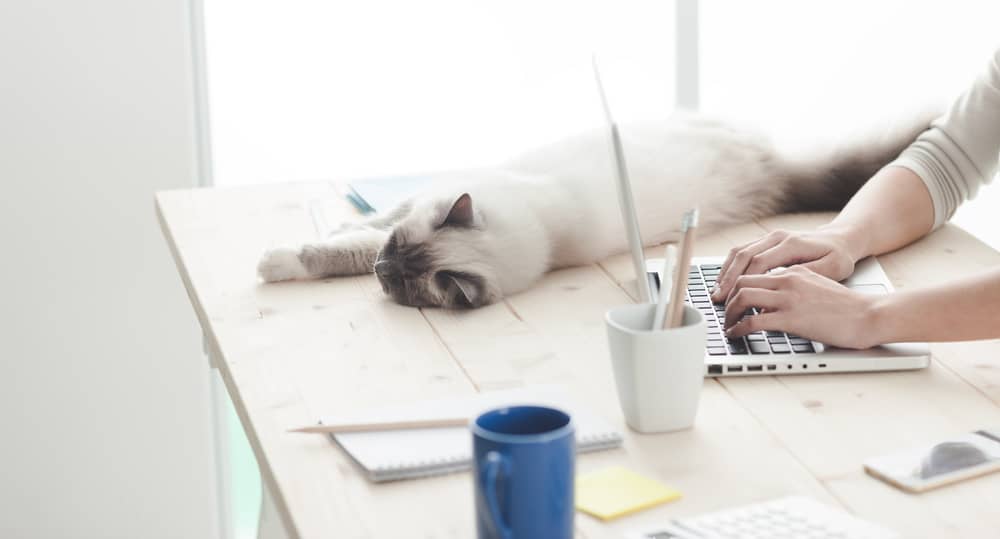If you are among the millions of Americans who work from home at least part of the time, you’ve probably noticed that you’ve needed to establish a few guidelines for you and for those who live with you. Your needs will vary depending on the work you need to do, but a home office or official work space is a must. Not sure how to organize your home office? Start with these tips.

Carve out a place to call your cubicle
No matter how small your home is, dedicate a spot that can be called your office for the work day. You may need to bring in equipment from your workplace to make the home office adequate, such as printers or lights. (Some employers are providing this equipment; ask before you go and buy your own.)
Find a space in your home that will accommodate the equipment you need. If you decide the dining room table is a great space for you to work, then this space should not be used for other purposes during that work time. Lunch should be served elsewhere.
Will this space be quiet enough for you to work? A spare room might be a better choice than a seat at the dining room table, if you share your home with others. Think creatively. Is there a little used area in your house — or even your garage or sun room — that would be more private? A friend’s husband recently transitioned to working at home. After a short time working from the master bedroom, he stapled old sheets and blankets on the walls of the unfinished basement to create the ultimate blanket fort office. It worked perfectly, giving him a space away from the family energy, and he didn’t have to clear his work off the bed every night.
Use DIY organizers for work materials
When you have a family, the home office often looks more like a kindergarten classroom with paper, pens, markers and more strewn around. Keep the kids’ art supplies somewhere else, and organize your space.

Sure, you could go into that fancy organization store that has containers of all shapes, sizes and colors. They even have containers you didn’t know you needed. But it’s easy to spend a small fortune in one of those places. Instead, make your own storage containers to clear up your clutter and pay little to nothing, depending on what you have in hand.
When it comes to office organization, it’s the little things that need to be corralled. The loose notes, the paper, pens, rubber bands, etc. Once you have a place to put all that stuff, you’ll notice your work area looking cleaner and easier to use. Organize your paper and scraps, as well as pens and ledgers, with boxes. All you need to make your own is a medium flat rate Priority Mail box (free at the post office) or other reusable box and some pretty paper. You can use gift wrap, newspaper, anything you like.
Put the box together and seal one side. Then, cut all four tabs off the open side. Next, using your paper as a guide, cut what will be the bottom so it is about 1 inch longer (measure from closed end to opened end) than the paper you plan to store in it. For my printer paper, I made the bottom about 12 1/2 inches long. Next, cut what will be the top, 2 inches shorter than the bottom. Then, cut the the side, angling from the bottom to the top. Look at the image to see my cut box. Finally, wrap it as you would a gift with your chosen paper and viola! Paper storage. It’s easy to make several boxes and stack them to store different types of paper or documents.

Here are more tips for storing office supplies:
Notes and paper scraps: We all have these — receipts, reminders, phone numbers and more. They easily pile up into a sea of colored paper. The key is getting them off the desk but keeping them in sight. I found a couple of decorative ways to do that, depending on your office style.
The first uses cookie sheets. You can use old ones, but depending on the shape your sheets are in, you may want to pick up an inexpensive one at Walmart or Target. You can use spray paint to make simple, color-coordinated magnetic boards to hang next to your desk. You can also use self-adhesive shelf liner to cover a cookie sheet with a pretty design or scrapbook paper as well.
You can also make a magnetic board using sheet metal, fabric and an old frame. Grab a piece of remnant fabric from the store if you don’t have any. And if you don’t have any unused frames, grab your Michael’s 40% off coupons and get a simple one at the store.
And of course, with a magnet board, you need magnets. You could buy some, but after making your fancy board, why not go one step further and whip up some magnets? There are tons of DIY magnets on Pinterest.
No white board? Grab an empty frame with intact glass and paint the back side with white paint. When it dries, hang it on the wall and use dry erase markers on the front side.
Pens, pencils, scissors: You can turn paper towel and toilet paper rolls (potato chip cans and oats canisters, too) into perfect containers for all these desktop essentials. Just collect the right sizes and use adhesive paper or wrapping paper to make a family of holders.
Is this spare bedroom deductible?
Now that you are working from home, you may be able to deduct the space on your tax return. Call your tax preparer about the guidelines for deducting a business run from home, and whether your transition to home as a part of your job will qualify. If it is within the guidelines, make sure you choose a completely separate area dedicated only to work. For instance, if you are working in your master bedroom, you probably won’t qualify to use this space as a deduction, because it is not a separate office space. Tax rules change quickly, so do your homework on this one and seek professional advice. Be sure to ask about the tax consequences when you sell your home, too.
Punch a time clock
It is very easy to wear more than one hat while you are home. The laundry needs to be done, dishes are piling up in the sink, and the kids want to go for a walk. But if you are working from home, schedule your day as if you are at work in a separate building. Clock in at the same time every day, and clock out at the end of the day. You can overwork and forget about the time when you are home. Keep your work day within the normal guidelines, and make time for your family and for yourself.

Similar articles at Living on the Cheap:
- How to make money working from home
- Smart advice about starting your home business
- Don’t miss out on work-related tax deductions
- Setting up your home office
- Mail packages from home



Incredible Post! This post is exceptionally enlightening and supportive. I got a lot of data and direction from this post. much obliged for sharing such a supportive post. Continue To post!!